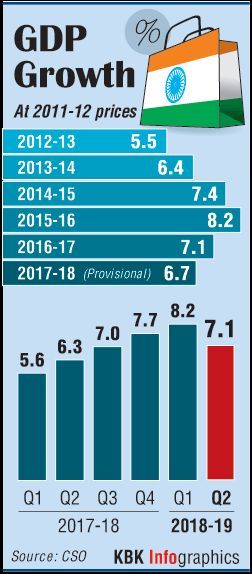 | « Back to article | Print this article |
The size of the GDP in the second quarter of 2018-19 is estimated at Rs 33.98 lakh crore, as against Rs 31.72 lakh crore a year ago
Illustration: Uttam Ghosh/Rediff.com

India's economic growth slowed to 7.1 per cent in the September quarter after peaking to an over two-year high in the first three months of this fiscal, as consumption demand moderated and farm sector displayed signs of weakness.
The growth in Gross Domestic Product (GDP) in July-September is the lowest in three quarters but better than 6.3 per cent in the same period of the previous year, helping the country retain the tag of the world's fastest-growing major economy, ahead of China.
The Indian economy had grown by 8.2 per cent in the first quarter of the current fiscal year that began in April, according to data released by the Central Statistics Office (CSO) on Friday.
The government, naturally, was disappointed but took comfort in the fact that the expansion was "robust and healthy" when the average rate for the first six months of the current fiscal are taken.
"GDP growth for second quarter 2018-19 at 7.1 per cent seems disappointing. Manufacturing growth at 7.4 per cent and agriculture growth at 3.8 per cent is steady.
“Construction at 6.8 per cent and mining at -2.4 per cent reflect monsoon months deceleration," economic affairs secretary Subhash Chandra Garg tweeted.
The growth during April-September stood at 7.6 per cent, which is "quite robust and healthy", he said. "Still, the highest growth rate in the world."
 The ministry of finance said the second quarter has seen a reasonable overall GDP growth.
The ministry of finance said the second quarter has seen a reasonable overall GDP growth.
"The growth in the second quarter is on higher base compared to the growth of the first quarter...The Indian economy is on track to maintain a high growth rate in the current global environment," it added.
The second quarter growth of 7.1 per cent keeps India ahead of China, which had expanded at the rate of 6.5 per cent in the July-September period this year.
In gross value added terms, the CSO data said the economy grew at 6.9 per cent in the July-September period, lower than 8 per cent GVA growth in the first quarter.
While the GVA gives a picture of the state of economic activity from the producers' side or supply side, the GDP projects the consumers' side or demand perspective.
The International Monetary Fund, in its latest World Economic Outlook, has pegged India's growth forecast for the current financial year at 7.3 per cent as the economy rebounds from the transitory turmoil of demonetisation and GST implementation.
Chairman of the Economic Advisory Council to Prime Minister (EAC-PM) Bibek Debroy said GDP estimates are a reflection of the government's successful policy efforts in maintaining a stable domestic environment despite global uncertainties.
The Gross Fixed Capital Formation as a ratio of GDP has increased by almost 1.3 percentage points on yearly basis.
The exports for second quarter have grown by 13.4 per cent.
The government consumption for the quarter has also significantly increased by 12.7 per cent.
GVA growth in the agriculture sector (including forestry and fishing) slowed to 3.8 per cent from 5.3 per cent in the previous quarter.
Commenting on the data, group executive and head (Global Markets Group), ICICI Bank, B Prasanna said: "We had only expected the growth to slow down meaningfully from Q3 onwards, especially given that the base effect in Q2 was fairly supportive."
Chief Economist with India Ratings and Research (Fitch Group) Devendra Kumar Pant said 2018-19 may still end up with a GDP growth of 7.3 per cent.
Meanwhile, data released by the the Controller General of Accounts (CGA) showed the full-year fiscal deficit target of Rs 6.24 lakh crore was breached at October-end mainly on account of lower revenue collections, reflecting deterioration in public finances.
The fiscal deficit or gap between expenditure and revenue was Rs 6.48 lakh crore or 103.9 per cent of the Budget Estimate (BE) during April-October of the current financial year.
At the end of October 2017-18, the deficit was 96.1 per cent of the BE.
The government has budgeted to cut fiscal deficit to 3.3 per cent of GDP in 2018-19 from 3.53 per cent in the previous financial year.
Another set of official data showed that the growth rate of eight infrastructure sectors slowed down to 4.8 per cent in October due to contraction in the production of crude oil, natural gas and fertilisers.
The eight infrastructure sectors of coal, crude oil, natural gas, refinery products, fertilisers, steel, cement and electricity had grown by 5 per cent in October 2017.
Fertiliser production dropped sharply by 11.5 per cent, crude oil by 5 per cent and natural gas by 0.9 per cent in October over the year-ago month, according to the data released by the commerce and industry ministry on Friday.
The production of coal, cement and electricity, on the other hand, expanded in the month under review.
During April-October 2018-19, the eight sectors recorded a growth rate of 5.4 per cent against 3.5 per cent in the same period last year.